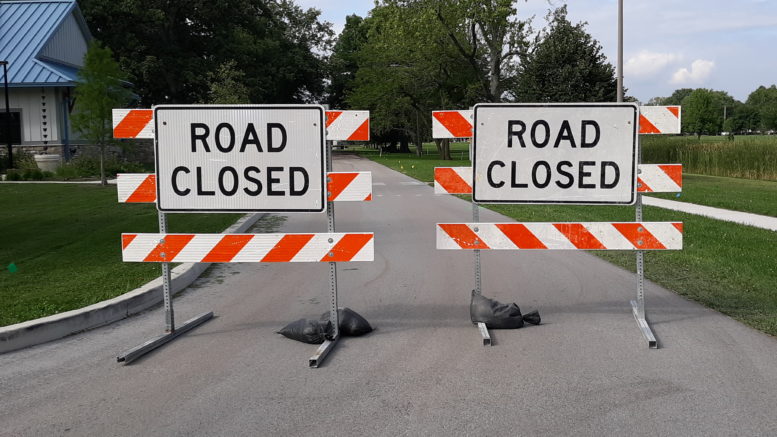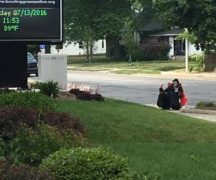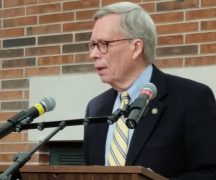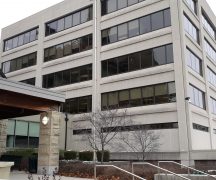By JAN LARSON McLAUGHLIN
BG Independent News
Wondering where the millions of dollars went that were awarded locally from federal COVID relief funding?
It’s being used to extend water and sewer lines to areas with none. It’s paving streets that had been on work lists but unfunded for years. It’s improving parks, which were lifesavers for local residents during the pandemic.
The Wood County Commissioners had $25.4 million to disperse, while the City of Bowling Green had $7.3 million to divide up. Elected officials saw the one-time funding as an opportunity to do a lot of good with a lot of money.
“The projects we picked were large projects that affected a large number of people,” Wood County Commissioner Doris Herringshaw said earlier this month.
And Bowling Green Mayor Mike Aspacher called the funding an “historic opportunity.”
The pots of money brought out requests for projects hungry for funding. The requests for funding far outnumbered the dollars available for the city and county.
Bowling Green still has $500,000 set aside to be awarded to non-profit agencies affected by COVID.
The city is urging applications be filed by March 31 from non-profit organizations, whose clientele are Bowling Green residents most negatively impacted by COVID, such as those with lower incomes, food insecurity or unemployed.
Interested non-profit applicants should contact Martha Woelke, Community Development Administrator for the City of Bowling Green, at 419-354-6220 or mwoelke@bgohio.org to get more information and an application package.
Following is a wrap-up of where funds have already been allocated by Wood County and Bowling Green.
Here’s where the money went …
The county received requests for nearly $42 million – $17 million more than it had to give away. The county’s available $25.4 million was divided into two spending areas:
- $15.4 million for American Rescue Plan Act projects eligible under the rules from the U.S. Treasury Department.
- $10 million that the county could claim as revenue lost due to COVID. This funding can be spent on government services with far fewer restrictions than ARPA projects.
The commissioners approved projects to fund from both buckets of money. In the funding specifically for ARPA projects, the county approved:
- $275,000 for premium pay for sheriff’s office and jail staff.
- $8.7 million for the water and sewer project on Ohio 582 to Dunbridge, requested by the Northwestern Water & Sewer District.
- $700,000 for water and sewer lines to the Mercer Road, Sugar Ridge area, also requested by the Northwestern Water & Sewer District.
- $1 million to identify and replace lead water lines throughout the county, requested by the Northwestern Water & Sewer District.
- $800,000 to the Cocoon Shelter for personnel costs.
- $437,500 for stormwater issues on Lime City Road, requested by the Wood County Engineer.
- $530,000 for stormwater issues on East Broadway Road, also requested by the Wood County Engineer.
- $1 million for elevated water storage and water lines in Pemberville.
- $1 million for water lines in North Baltimore.
- $400,000 for Habitat for Humanity of Wood County for personnel and program costs.
- $450,000 for the Wood County Health Department building expansion.
In the $10 million fund to make up lost revenue for the county, the commissioners approved:
- $394,673 for a stormwater study requested by the Wood County Engineer.
- $3 million for expansion of the Wood County Landfill.
- $4.3 million for air handling systems in the county buildings.
- $2.3 million to Wood County Sheriff’s Office for CAD dispatching improvements to services for 42 police, fire and EMS agencies.
Bowling Green was awarded $7.2 million in 2021 in American Rescue Plan Act funds designed to help the community recover from the economic impacts of the COVID pandemic.
City Council received more than 450 funding suggestions from Bowling Green citizens, non-profit agencies, businesses and city government.
Early on, the city dedicated funds to infrastructure projects:
- $3 million for residential street paving.
- $350,000 for MARCS radios to improve public safety communications.
- $250,000 for paving at City Park, including road widening, a walking path, and security improvements.
- $100,000 for an inclusive playground at Carter Park.
- $300,000 for housing grants over three years.
Then the city asked for proposals, and gave away another $2 million in the fall of 2022.
The projects were scored on a rubric which ranked them on criteria such as the frequency of the requests, the continuing expenses required, the chances of matching or in-kind funding, the degree the project is already being address by another entity, whether or not the project was directly impacted by COVID, the number of BG residents who could be positively impacted, and the positive impact on the local economy.
Projects getting pieces of the funding pie included:
Downtown improvements
- $75,000 for downtown public restrooms in the former drive-thru bank next to the police station.
- $100,000 for an alley revitalization project requested by the Downtown BG Special Improvement District.
Park improvements
- $180,000 to help build the shared use path from the high school to the community center and to the Cogan’s Crossing housing development north of Bishop Road. The city had already secured a grant for 90% of the project which is already underway.
- $150,000 for the proposed pickleball courts next to the community center. By allocating some funds now, the project may be better equipped to apply for grants and matching funds.
- $150,000 to go toward establishing walkable dog parks closer to city neighborhoods. This funding will help the citizens group pushing for the dog parks to secure matching grants.
- $20,000 to update and improve the disc golf course in Carter Park.
Other funding winners:
- $350,000 to pay for inflationary cost overruns in the city’s residential street paving program due to supply chain issues, labor shortages and inflation.
- $75,000 for an innovation and entrepreneurship accelerator feasibility analysis and business plan requested by BG Economic Development.
- $100,000 annually for the next three years for housing assistance grants offered by the city for owner-occupied homes.
- $25,000 for a feasibility study for a hike-bike trail from Crim Elementary School to Carter Park. The funding was requested by the East Side neighborhood residential group.





